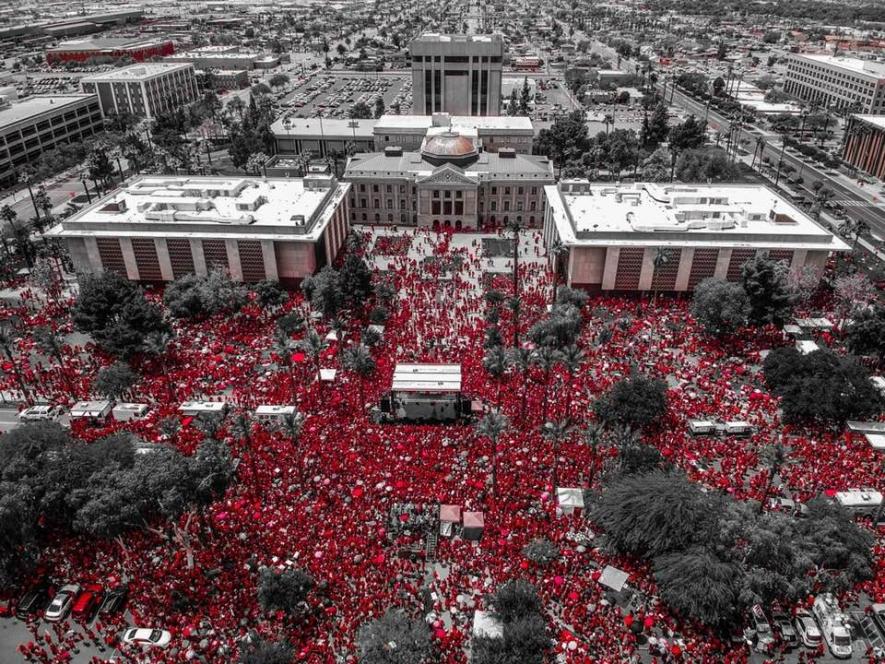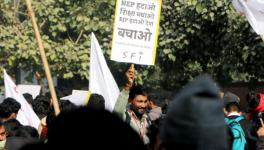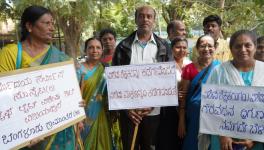RedforEd Sees Over 50,000 Teachers Protest in Arizona

The over 50,000 protesters plan to continue their protest in front the State Capitol until their demands are met: Photo Ernie Somoza
A sea of red took over the area around the State Capitol in Arizona on April 26 as over 50,000 educators, support staff, parents and activists began an indefinite strike, one of the biggest in recent times in the United States. The strike, under the banner of the RedforED campaign, comes in the wake of similar struggles in West Virginia, Oklahoma and Kentucky, and marks a fight back against decades of policies that have steadily eroded the foundations of the education system in the country.
A hike in salaries – Arizona teachers are among the worst paid in in the country – is a key demand but the educators’ aims are far more ambitious and seek to strike at the root of policies that have been destroying the education system. Among their demands are pay hikes for support staff, returning school funding to pre-2008 levels and infrastructural upgrades and new technology for schools. The educators have also demanded that no tax cuts be implemented till per-pupil spending reaches the national average and that social spending for socio-economically disadvantaged families and individuals be not affected during the reallocation of tax revenues. The protesters have thus directly targeted two key strategies of the neo-liberal reform regime of the past three decades – tax cuts for the privileged and cuts on social spending, often under the pretext of funding other social programs.
In fact, the educators rejected a recent proposal by Governor Doug Ducey for a 20% raise in their salaries by 2020 as it was only for teachers and not support staff, and did not address the structural concerns raised by them. Various organizations also pointed out that the Governor’s proposal would lead to fund cuts from other vital services. Support staff in schools called the proposal an attempt to divide the protesters.
Arizona, like many other States in the Republican heartland, has seen its education infrastructure crumble over the years. Activists say there is a $1 billion gap in funding from the pre-recession era. Funding per student (after being adjusted for inflation) declined by 14% from 2008. “We’re using textbooks from the 1990s because there’s no money for books,” said Joe Thomas, President of the Arizona Education Association, a teachers’ union. Class sizes are among the highest in the country. “Over 2,000 teachers’ positions are vacant while 3,400 classrooms are led by people without adequate qualifications,” notes a video from the Arizona Educators United, a grassroots organization.
Despite the crying need for resources, the State has consistently refused to raise taxes even as tax cuts have led to a huge fall in revenue from corporates. In response, the Arizona Schools Now, a coalition of stakeholders seeking an improvement in funding for public schools, has come up with a series of steps to raise revenue for education. These include a freeze on individual and corporate income tax cuts that are being phased in, an increase in the minimum corporate income tax to $500 and a hike of income tax rates for households with incomes above $500,000. However, there has been hardly any response from the State Legislature, which in fact went into recess in the face of the tens of thousands gathering at the Capitol on April 26.
While these crises has been building up for years, the landmark strike was the result of months of dedicated organising and capacity-building by teachers and support staff, inspired by the West Virginia strike. Spearheaded by the Arizona Educators United and the Arizona Education Association, the organizing began with educators wearing red to schools, followed by walk-ins, where awareness was raised on the issue and members across the State mobilised. This patient and intensive work over nearly 2 months saw nearly 78% of the State’s nearly 60,000 educators voting in favour of a walk-out, according to union sources.
#Redfored Eve at 11pm. I just got home from work because I work 4 jobs to support my family. I’m not walking OUT- I’m walking FOR- my students AND my own children. They ALL deserve my time, my attention and my very BEST- 100%! @AZ1Thomas pic.twitter.com/Vwemwq38wY
— dadams (@adams4az) April 26, 2018
The strike has thrown a direct challenge to the administration of Arizona and its legislature. Speaking to The Dawn News just before the second day of protests, Noah Karvelis, one of the key mobilisers of the strike, said, “Next, we return to the Capitol to demand answers. Unfortunately, our legislature have adjourned for the weekend. But, we will be there regardless to keep fighting. From there, the educators will decide what comes next.” The struggle over the next few days will have huge implications for the future of labour movements, not just in the State but across the country.
Get the latest reports & analysis with people's perspective on Protests, movements & deep analytical videos, discussions of the current affairs in your Telegram app. Subscribe to NewsClick's Telegram channel & get Real-Time updates on stories, as they get published on our website.
























